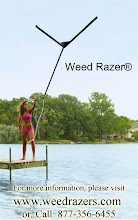Cattail (invasive aquatic weed) is competitively superior under stable water conditions. Maintaining open areas in semi-permanent marshes is difficult once the plant is established. The plant can occur in a variety of natural communities and form extensive monocultures rapidly through vegetative reproduction, thereby reducing plant bio-diversity.
Cattail can become a problem in irrigated agricultural lands and managed aquatic systems. The plant invades farm ponds, irrigation canals, and drainage ditches which can result in impeded water flow and increased siltation.



Hydrilla (the perfect lake weed / pond weed) is a perennial, which means the leaves and stems die when the weather gets cold, but the roots continue to live in the soil. When the weather gets warm again, the roots send up new stems and leaves.
ReplyDeleteHydrilla spreads through fragmentation, when stems get broken, the pieces can become a new plant.
Hydrilla can also spread when it produces flowers. Hydrilla flowers are tiny and white. They float on the surface, just above the water.
Hydrilla is a fast growing, very competitive plant that can push out other plants, lake weeds, and pond weeds.
Even though Hydrilla causes lots of problems for some species of plants and animals, it can help others by providing cover and shelter. Fish, frogs, turtles, and aquatic insects can all hide in
Hydrilla and use it for protection. If the Hydrilla grows too thick, though, these animals may have trouble getting around it.
Some animals that eat Hydrilla include turtles and carp….